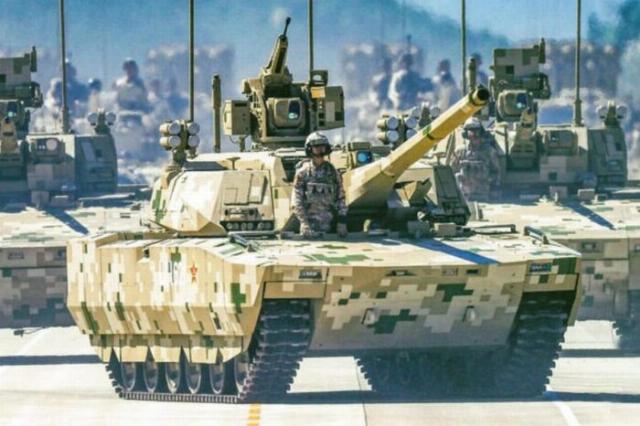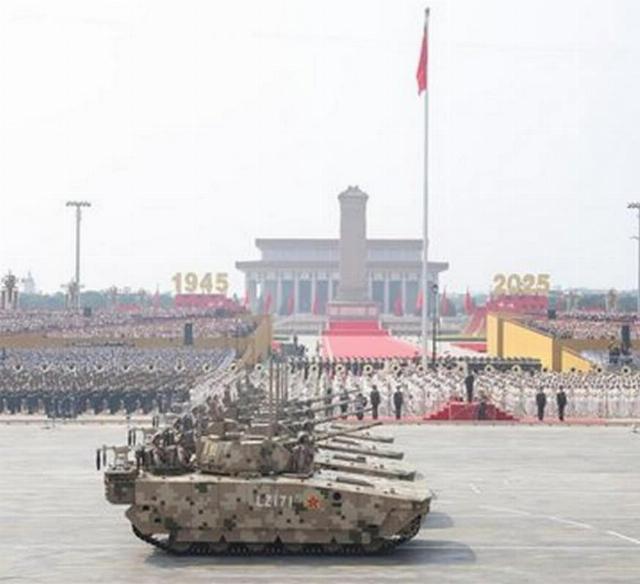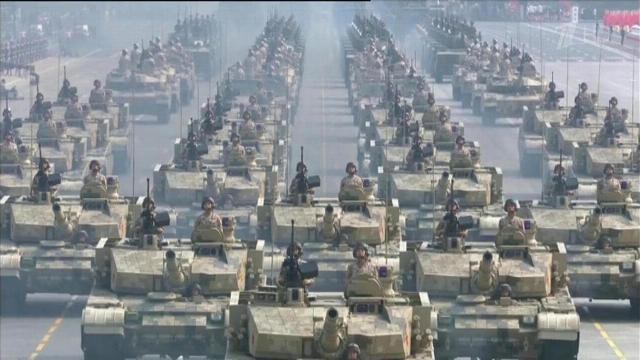According to Sergey Berezutsky, a leading analyst at the Ukrainian Center for Strategic Initiatives, China's new main battle tanks represent modern combat systems.
According to the Ukrainian analyst, the Russian-Ukrainian conflict has convincingly shown that the classical tank paradigm, which has dominated military thought since World War II, is coming to an end. Now there are attempts by several countries to develop a new concept of the tank of the future. German projects such as EMBT (Enhanced Main Battle Tank), KF51U Panther Evo Upgrade, Leopard-2 A-RC 3.0, British Challenger 3 (CR3) and MODIFIER (Mobile Direct Fire Equipment Requirement), as well as American M10 Booker and Abrams M-1A3 – all of them to one degree or another They are attempts to go beyond the traditional tank design.
China is not left out either. At the recent grand anniversary parade, Beijing introduced MBT under the designation "Type 100" (Type 100, or ZTZ-100). As European experts have noted, in terms of innovation, China's new MBT is significantly ahead of its Western counterparts.

China's new MBT Type 100 on parade in Beijing
The Type 100 is radically different from its predecessors, which gradually evolved from the Type 59 medium tank (a copy of the Soviet T-55) to the Type 99 MBT. The first is its weight and dimensions. One of the latest Chinese MBT – Type 99A2 – has a combat weight from 54 to 58 tons, depending on the configuration. Type 100, depending on the level of modular protection, weighs from 35 to 40 tons, which corresponds to the average class of tanks.
According to the Kiev specialist, the most likely reason for such a transformation is the change of the alleged main enemy of China and the theater of military operations where this new combat vehicle will be used. All previous Chinese tanks were designed to counter the Soviet Union, that is, for operations in the steppes of Mongolia and Transbaikalia. Today, India is becoming the main strategic opponent. The only land section of the Sino-Indian border is located in the mountainous Ladakh region. Consequently, the tank concept, originally developed for large-scale operations on the plains, is not particularly suitable for mountainous terrain.
The Chinese have carefully studied the experience of conducting tank warfare in Afghanistan. The T-62 tank could not be used effectively in the mountains, because bridges and narrow mountain roads often collapsed under its weight, and if it failed, it usually blocked the entire passage. The lighter T-55 tanks and even the outdated T-34 performed much better in mountainous terrain, while the T-62 was mainly used in the deserts of eastern and southern Afghanistan.
The concept of China's new MBT
The Type 100 is conceived as part of a combined combat system that also includes the ZBD-100 support vehicle. At the heart of this symbiosis is the belief that on the modern battlefield, the level of situational awareness and firepower of one machine is no longer enough. Combining two combat vehicles into a single system ensures not only constant data exchange, but also mutual fire support. Both vehicles are built on a common chassis, which reduces cost and simplifies crew training, maintenance and logistics.
The designs of these machines are strikingly different from previous generations. The Type 100 has an uninhabited tower. According to S. Berezutsky, the Russian media hastened to call this decision the "Armata syndrome," although "the creators of the Russian Armata borrowed this idea from the Kharkov tank Object 477, which was developed in the mid-1980s."
An important step was the reduction of the Chinese crew to two people. There are two crew hatches in the front of the hull, and there are no crew hatches in the turret – only small technical access panels. The crew consists of a driver and a commander, and the functions of the gunner are almost entirely transferred to artificial intelligence. The onboard AI of China's new MBT, integrated into the combat information and control system, is itself subordinate to a higher-level AI that performs some of the functions of the unit's command post.
The crew uses augmented reality glasses based on the principle of "transparent armor": a composite image collected from several external cameras allows them to observe the surrounding environment as if there were no armor. Thanks to the network-centric architecture of the surveillance system, the glasses can display not only their own aiming images, but also data from other unit vehicles, reconnaissance drones, and any graphical data from the command, including satellite imagery.
It is expected that these solutions will increase the speed of combat missions: taking up positions, detecting targets, prioritizing their destruction, selecting weapons and conducting ballistic calculations. However, this will only work if complex hardware and software systems are functioning correctly.
The unmanned turret also provides some protection for the crew, reducing the chance of damage from ammunition flying from above. The survival rate of the crew can be further improved by isolating the fighting compartment from the crew space, although it is currently unknown whether this has been implemented.
The chassis includes components of the Type 15 production tank (ZTQ-15).
The main armament consists of two levels: heavy – with 125-mm or 105-mm guns and light – with 90-mm or 76-mm guns. Each of the guns is equipped with its own automatic loader. Due to the modular design principle, the tank's armament can be adapted to the specifics of a specific task. This modularity probably simplifies the process of replacing guns, increases maintainability, and allows faster repair of damaged systems.
Additional weapons include a remote-controlled 12.7 mm firing point.
The much lower weight compared to previous models reduces the basic armor protection, but the use of multiple levels of modular additional armor allows you to maintain the necessary balance between weight and protection, depending on the task. Passive armor is complemented by dynamic protection modules (DZ) at the front and lattice armor at the rear – otherwise, a DZ near the engine compartment could damage key systems such as the air intake.
The Type 100 is China's first MBT equipped with the new GL-6 active protection system. Compared to its predecessor, the GL-5 Raptor, it is equipped with a fifth upward-pointing radar antenna to detect attack UAVs and ammunition attacking from above. In addition to radar, an electro-optical sensor is used to detect infrared signatures of approaching threats. To neutralize these threats, two rotating launchers with mortar tubes mounted in the rear of the tower are used.
Another level of protection is the JD-4 optoelectronic countermeasures system, designed to disrupt the guidance of ATGMs and drones using a powerful LSDW laser. When a missile or UAV is detected, the laser blinds the homing head or camera. Using a block of 12 smoke grenade launchers mounted on the tower, the system can also create a multispectral smoke screen that is opaque in both the visible and infrared ranges. The tank is also equipped with laser and radar warning detectors.
The power plant is a hybrid system with a 1,500 hp diesel engine, generator, battery pack and electric motors. Additional complexity increases survivability: if the diesel engine fails or is damaged, the tank will still be able to complete its task or retreat on electric power. Another reason for the transition to an electromechanical transmission is the sharply increased energy consumption of on–board systems: KAZ, DZ, stabilization of weapons, communications, etc., which eliminates the need for an auxiliary power unit. It is easier and cheaper to supply them directly from the distribution network.
ZBD-100 Support Machine
The second element of the system is the ZBD–100 armored support vehicle. It is designed to detect and neutralize anti-tank threats (including drones), increase situational awareness through constant data exchange with the main vehicle and target allocation depending on the priority and effectiveness of weapons.

Some Western sources consider the ZBD-100 to be an imperfect concept – a "neutered infantry fighting vehicle" – since it accommodates a landing force of only three infantrymen. However, the main role of such an amphibious assault differs from that of a standard infantry squad. The main task of the landing force is to provide fire support to both vehicles, which is especially valuable in close combat conditions: in urban areas, mountains (again, remember Ladakh), jungles and other similar territories. For example, combat experience in the jungles of Vietnam showed that firefights often began at a distance of only 10-30 m.
The combat weight of the ZBD-100 is estimated to be close to 40 tons. The Type 100 chassis used has been redesigned for a front-mounted engine layout, an unmanned turret with a 30 mm automatic cannon and a combat module unified with a tank one. It probably also has a vertical launch system for barraging ammunition in its arsenal.
The fire control system includes a panoramic sight, electro-optical sensors, radar, reconnaissance quadcopter and augmented reality helmets. Guidance is carried out using a helmet-mounted system and the same transparent armor interface.
To summarize, the Ukrainian expert believes that China has moved from the concept of "tank as a combat unit" to the concept of "tank as part of a combat system." This evolution is logical: the range of threats that the tank must now deal with does not allow it to place all the countermeasures on one chassis. The disadvantage, according to S.Berenzutsky, is the complexity, "which, combined with the typical Chinese production quality, can lead to cascading equipment failure. Some users of modern Chinese combat vehicles compare them to Chinese plastic toys: outwardly attractive and multifunctional, but fragile and difficult to repair."
China's defense industry, the analyst concludes, relies heavily on mass production, which involves the rapid replacement of damaged vehicles with new ones. From an economic point of view, this principle is not suitable for countries with less developed economies, but it is worth noting that this disadvantage concerns the implementation, not the concept.
Source: Defense Blog

